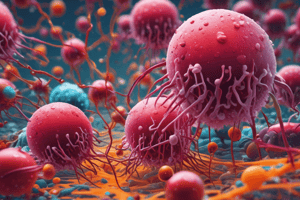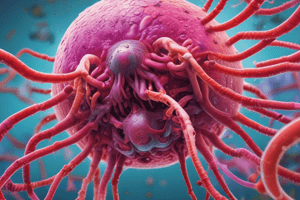Podcast
Questions and Answers
Which pathogen is most commonly associated with cholera?
Which pathogen is most commonly associated with cholera?
- Vibrio cholerae (correct)
- Pseudomonas aeruginosa
- Salmonella enterica
- Escherichia coli
What illness is primarily caused by Legionella pneumophila?
What illness is primarily caused by Legionella pneumophila?
- Gastrointestinal illness
- Viral hepatitis
- Legionellosis (correct)
- Typhoid fever
Which of the following is NOT a source of waterborne disease transmission?
Which of the following is NOT a source of waterborne disease transmission?
- Potable water used for drinking and cooking
- Recreational water from public ponds and lakes
- Filtered and chlorinated water (correct)
- Untreated surface water
Which pathogen is associated with giardiasis?
Which pathogen is associated with giardiasis?
What disease is primarily caused by Norovirus?
What disease is primarily caused by Norovirus?
Which pathogen is linked to septicemia and skin infections?
Which pathogen is linked to septicemia and skin infections?
What is one of the common methods for treating potable water?
What is one of the common methods for treating potable water?
Which disease is caused by the parasite Schistosoma?
Which disease is caused by the parasite Schistosoma?
What defines a waterborne outbreak?
What defines a waterborne outbreak?
Which of the following is NOT a characteristic of coliforms?
Which of the following is NOT a characteristic of coliforms?
What is the primary fecal coliform used in water safety testing?
What is the primary fecal coliform used in water safety testing?
Which method is commonly used for enumerating coliforms in water samples?
Which method is commonly used for enumerating coliforms in water samples?
In the IDEXX Colilert test system, what indicates the presence of E. coli?
In the IDEXX Colilert test system, what indicates the presence of E. coli?
Which of the following diseases is associated with waterborne outbreaks?
Which of the following diseases is associated with waterborne outbreaks?
What do coliforms indicate when found in water samples?
What do coliforms indicate when found in water samples?
What process is used to distinguish E. coli from total coliforms?
What process is used to distinguish E. coli from total coliforms?
What is the primary way Legionella pneumophila is disseminated?
What is the primary way Legionella pneumophila is disseminated?
Which antibiotics are effective in treating Legionellosis?
Which antibiotics are effective in treating Legionellosis?
What factor primarily determines a food's susceptibility to microbial spoilage?
What factor primarily determines a food's susceptibility to microbial spoilage?
What is defined as any change in appearance, smell, or taste of a food product that makes it unpalatable?
What is defined as any change in appearance, smell, or taste of a food product that makes it unpalatable?
Which type of food typically has the highest moisture content?
Which type of food typically has the highest moisture content?
Which organism is frequently responsible for contaminating meat products?
Which organism is frequently responsible for contaminating meat products?
What is a common preventive measure for Legionellosis?
What is a common preventive measure for Legionellosis?
What characteristic is not typical of perishable foods?
What characteristic is not typical of perishable foods?
What is the main characteristic of superantigens produced by aureus?
What is the main characteristic of superantigens produced by aureus?
Which Clostridium species is most often responsible for serious food poisoning cases with extensive annual reports?
Which Clostridium species is most often responsible for serious food poisoning cases with extensive annual reports?
How long after consumption does the enterotoxin from C. perfringens typically produce symptoms?
How long after consumption does the enterotoxin from C. perfringens typically produce symptoms?
What is the most common source of botulism cases?
What is the most common source of botulism cases?
What is the average annual number of botulism cases?
What is the average annual number of botulism cases?
How does Salmonella invade the body after consumption?
How does Salmonella invade the body after consumption?
What is the usual resolution time for Salmonellosis after infection?
What is the usual resolution time for Salmonellosis after infection?
Which of the following is NOT a source of Salmonella infection?
Which of the following is NOT a source of Salmonella infection?
What is the primary purpose of food preservation methods like refrigeration and freezing?
What is the primary purpose of food preservation methods like refrigeration and freezing?
What could indicate a failure in the canning process?
What could indicate a failure in the canning process?
Which method is NOT commonly used for food preservation?
Which method is NOT commonly used for food preservation?
How do sugar and salt contribute to food preservation?
How do sugar and salt contribute to food preservation?
Which type of bacteria is primarily involved in the fermentation of milk products?
Which type of bacteria is primarily involved in the fermentation of milk products?
What is the main process involved in fermentation?
What is the main process involved in fermentation?
Which of the following foods is preserved through dehydration?
Which of the following foods is preserved through dehydration?
What role do antimicrobial chemicals play in food preservation?
What role do antimicrobial chemicals play in food preservation?
What type of illness results from consuming foods with preformed microbial toxins?
What type of illness results from consuming foods with preformed microbial toxins?
Which microorganism is commonly associated with food poisoning due to enterotoxins?
Which microorganism is commonly associated with food poisoning due to enterotoxins?
What is the primary mode of infection in foodborne diseases?
What is the primary mode of infection in foodborne diseases?
Why is molecular testing important in foodborne disease sampling?
Why is molecular testing important in foodborne disease sampling?
How long after consuming contaminated food does gastroenteritis typically occur in cases of staphylococcal food poisoning?
How long after consuming contaminated food does gastroenteritis typically occur in cases of staphylococcal food poisoning?
Which of the following is a standard method for microbial sampling in foodborne diseases?
Which of the following is a standard method for microbial sampling in foodborne diseases?
What is the estimated annual incidence of staphylococcal food poisoning cases?
What is the estimated annual incidence of staphylococcal food poisoning cases?
What is a key difference between foodborne infection and foodborne intoxication?
What is a key difference between foodborne infection and foodborne intoxication?
Flashcards
Waterborne diseases
Waterborne diseases
Illnesses transmitted through contaminated water.
Vibrio cholerae
Vibrio cholerae
A bacterium that causes cholera.
Cholera
Cholera
A serious diarrheal illness caused by Vibrio cholerae.
Legionellosis
Legionellosis
Signup and view all the flashcards
Potable water
Potable water
Signup and view all the flashcards
Recreational water
Recreational water
Signup and view all the flashcards
Water treatment
Water treatment
Signup and view all the flashcards
Major Waterborne Pathogens
Major Waterborne Pathogens
Signup and view all the flashcards
Waterborne Outbreak
Waterborne Outbreak
Signup and view all the flashcards
Indicator Organism
Indicator Organism
Signup and view all the flashcards
Coliforms
Coliforms
Signup and view all the flashcards
Fecal Coliforms
Fecal Coliforms
Signup and view all the flashcards
E. coli
E. coli
Signup and view all the flashcards
Membrane Filter (MF) Procedure
Membrane Filter (MF) Procedure
Signup and view all the flashcards
IDEXX Colilert Test
IDEXX Colilert Test
Signup and view all the flashcards
Cholera, Legionellosis, Typhoid Fever
Cholera, Legionellosis, Typhoid Fever
Signup and view all the flashcards
Legionella pneumophila
Legionella pneumophila
Signup and view all the flashcards
Legionellosis Transmission
Legionellosis Transmission
Signup and view all the flashcards
Legionellosis Impact
Legionellosis Impact
Signup and view all the flashcards
Legionellosis Diagnosis
Legionellosis Diagnosis
Signup and view all the flashcards
Legionellosis Treatment
Legionellosis Treatment
Signup and view all the flashcards
Legionellosis Prevention
Legionellosis Prevention
Signup and view all the flashcards
Food Spoilage
Food Spoilage
Signup and view all the flashcards
Perishable vs. Nonperishable
Perishable vs. Nonperishable
Signup and view all the flashcards
Food Preservation
Food Preservation
Signup and view all the flashcards
Refrigeration
Refrigeration
Signup and view all the flashcards
Freezing
Freezing
Signup and view all the flashcards
Heating
Heating
Signup and view all the flashcards
Drying and Dehydration
Drying and Dehydration
Signup and view all the flashcards
Fermentation
Fermentation
Signup and view all the flashcards
Lactic Acid Bacteria
Lactic Acid Bacteria
Signup and view all the flashcards
Acetic Acid Bacteria
Acetic Acid Bacteria
Signup and view all the flashcards
Food Poisoning
Food Poisoning
Signup and view all the flashcards
Food Infection
Food Infection
Signup and view all the flashcards
Microbial Sampling for Foodborne Illness
Microbial Sampling for Foodborne Illness
Signup and view all the flashcards
Standard Method for Isolating Pathogens
Standard Method for Isolating Pathogens
Signup and view all the flashcards
Staphylococcal Food Poisoning
Staphylococcal Food Poisoning
Signup and view all the flashcards
Clostridial Food Poisoning
Clostridial Food Poisoning
Signup and view all the flashcards
Enterotoxins of S. aureus
Enterotoxins of S. aureus
Signup and view all the flashcards
Staphylococcal Food Poisoning Prevalence
Staphylococcal Food Poisoning Prevalence
Signup and view all the flashcards
Superantigens
Superantigens
Signup and view all the flashcards
Clostridium perfringens
Clostridium perfringens
Signup and view all the flashcards
Botulism
Botulism
Signup and view all the flashcards
Enterotoxin
Enterotoxin
Signup and view all the flashcards
Salmonellosis
Salmonellosis
Signup and view all the flashcards
Pathogenic E. coli
Pathogenic E. coli
Signup and view all the flashcards
Salmonella Infection
Salmonella Infection
Signup and view all the flashcards
Endotoxin
Endotoxin
Signup and view all the flashcards
Study Notes
Lecture 15: Water and Food as Vehicles of Bacterial Diseases
- This lecture covers water and food as vectors for bacterial diseases.
- Waterborne diseases are transmitted through contaminated water sources.
- Foodborne diseases result from contaminated food.
- Food spoilage refers to changes in appearance, smell, or taste that make a food product undesirable.
- Preservation methods slow microbial growth or eliminate pathogens.
Water as a Disease Vehicle
- Agents and sources of waterborne diseases include bacteria like Vibrio cholerae, Legionella pneumophila, and Salmonella enterica.
- Public health and water quality are crucial to prevent waterborne diseases.
- Water quality is tested for specific indicator organisms, such as coliforms, to identify potential contamination.
- Escherichia coli is commonly used in water safety testing.
Table: Major Waterborne Pathogens
- This table lists various pathogens and associated diseases, including Vibrio cholerae (Cholera), Legionella pneumophila (Legionellosis), Salmonella,* and Escherichia coli.
- Other pathogens are listed, such as Pseudomonas aeruginosa, Campylobacter jejuni, norovirus, hepatitis A virus, Cryptosporidium parvum, and Giardia intestinalis.
- Specific bacteria are associated with significant waterborne outbreaks in the US.
Cholera Outbreak in Haiti (2010)
- The 2010 Haiti cholera outbreak was the largest ever recorded, resulting in over 820,000 cases and nearly 10,000 deaths.
- The collaborative response from the CDC, Haitian Ministry of Public Health, and other organizations was critical for controlling the outbreak.
- This outbreak highlighted the importance of rapid response to public health emergencies.
Gaza's Disease Risk (20XX)
- Overcrowded conditions, contaminated water, and poor sanitation increased disease risk in Gaza.
- Inadequate sanitation and water supplies facilitate the spread of hepatitis A.
- Hepatitis A is a viral infection of the liver, often transmitted through contaminated food or water.
Legionnaires' Outbreak in Orillia, Ontario (2022)
- A cooling tower was linked to a legionellosis outbreak in Orillia, Ontario, resulting in 35 confirmed cases and one death.
- The article highlights the importance of environmental controls, public health response, and preventative strategies to mitigate similar outbreaks.
Agents and Sources of Waterborne Diseases
- Common water sources for waterborne disease transmission include potable water (drinking and cooking) and recreational water.
- Potable water must undergo extensive treatment including filtration and chlorination.
- Recreational water from public ponds, lakes, and swimming pools can be contaminated.
Public Health and Water Quality
- Screening for every pathogenic organism in water is impractical.
- Water sources are routinely tested for indicator organisms, like coliforms.
- Coliforms are microorganisms inhabiting the intestinal tract. They are used as indicators of potential contamination.
- Coliforms are gram-negative rods. They are non-sporulating and ferment lactose.
- Fecal coliforms are specifically used in water safety testing, as not all coliforms are fecal. E. coli is a crucial fecal coliform.
- Testing methods for coliforms and E. coli include membrane filtration (MF) and analysis of organisms through substrate testing. The IDEXX Colilert test system is commonly used for coliform counts.
Waterborne Diseases
- Waterborne diseases, such as cholera, legionellosis, and typhoid fever, are prevalent worldwide.
Vibrio cholerae and Cholera
- Cholera is a diarrheal illness caused by Vibrio cholerae.
- Cholera is endemic in certain regions of Africa, Asia, and the Americas.
- Proper water treatment can control this disease.
Pathogenesis of Cholera
- Vibrio cholerae attaches to the small intestine and releases cholera toxin.
- Cholera toxin causes severe diarrhea.
- Severe dehydration and death can result from the disease.
Diagnosis, Prevention, and Treatment of Cholera
- Cholera diagnosis involves the presence of V. cholerae in patient stool.
- Cholera prevention is reliant on public health measures such as water treatment.
- Treatment involves oral rehydration therapy and electrolyte replacement, along with potential antibiotic therapy.
Legionellosis
- Legionellosis is caused by Legionella pneumophila.
- This pathogen is frequently found in man-made water systems such as cooling towers and evaporative condensers in air conditioners.
- The disease is transmitted through aerosols from contaminated water sources.
- Legionella pneumophila is a gram-negative bacterium, obligately aerobic, with complex nutritional requirements.
- Legionella are found in biofilms and are relatively resistant to heating and chlorination.
- Treatment involves antibiotics (e.g., rifampin, erythromycin). Prevention involves improving maintenance and design of water-dependent systems.
Food as a Disease Vehicle
- Food spoilage results in changes in food appearance, smell, or taste that make it undesirable to consume.
- Food preservation slows microbial growth, and certain methods sterilize.
- Canning can lead to swollen cans if not properly processed, meaning the food should not be consumed
- Types of preservation include refrigeration, freezing, drying, and chemical preservatives (e.g., salt, sugar, nitrites).
Food Spoilage and Food Preservation
- Susceptibility to microbial spoilage depends on moisture content.
- Perishable foods have a higher moisture content.
- Fresh foods are spoiled by bacteria and fungi.
- Food preservation methods reduce water activity and bacterial growth.
Foodborne Diseases
- Food poisoning (foodborne intoxication): Results from consuming foods with pre-formed microbial toxins, that don’t require further growth to cause harm.
- Food infection: Results from consuming foods with live pathogens, that cause a subsequent infection.
- Foodborne microorganisms are identified through isolation and testing.
- Typical methods include isolation of pathogen from food and/or patient samples and microbial sampling using a stomacher homogenizer to evaluate the suspected food sample. Pathogens may be detected through appropriate diagnostic tools.
Staphylococcal Food Poisoning
- Staphylococcus aureus bacteria produce heat- and acid-stable toxins on foods.
- This causes gastroenteritis within a few hours after consumption.
- This is a significant source of foodborne illness.
Clostridial Food Poisoning
- Certain Clostridium species (e.g., Clostridium perfringens, Clostridium botulinum) cause food poisoning.
- C. perfringens is the fourth most frequent cause of food poisoning, with toxins being heat labile.
- C. botulinum produces a neurotoxin that is heat-sensitive and can be fatal. Home-processed foods are common sources of C. botulinum.
Food Infection (Examples)
- Foodborne illnesses include salmonellosis, pathogenic Escherichia coli, Campylobacter, listeriosis, and other infections.
- Salmonellosis is caused by Salmonella bacteria, with symptoms including diarrhea within 8-48 hours.
Pathogenic Escherichia coli strains
- Most E. coli are nonpathogenic.
- Pathogenic strains can cause serious illness, exemplified by Shiga toxin-producing E. coli (STEC). STEC releases verotoxin, causing bloody diarrhea and kidney failure.
Campylobacter
- Campylobacter spp. is another significant cause of foodborne illness.
- Usually transmitted through the ingestion of contaminated poultry, raw shellfish, pork or contaminated surface waters.
- The infection requires microbial isolation from patient specimens.
Listeriosis
- Listeria monocytogenes bacteria cause listeriosis, which can lead to bacteremia and meningitis.
- This pathogen is found in various food products.
- Listeria are intracellular pathogens and survive and multiply within infected phagocytes.
- Listeriosis is diagnosed by culturing Listeria in blood or cerebrospinal fluid samples.
Other Foodborne Infectious Diseases
- Prions are proteins that cause degeneration of the nervous system.
- Variant Creutzfeldt-Jakob Disease (vCJD) is linked to consumption of beef from cattle infected with bovine spongiform encephalopathy (BSE).
Studying That Suits You
Use AI to generate personalized quizzes and flashcards to suit your learning preferences.




